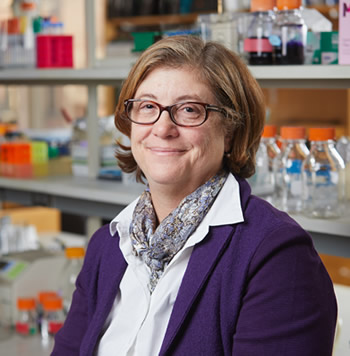By Dr. Homa Ghalei
 The discovery of pre-mRNA splicing in non-viral mRNAs in 1977 by the laboratories of Drs. Richard Flavell and Philip Leder made Dr. Susan Baserga recognize that “RNA was a fascinating molecule, and there was much to be done to probe its mysteries.” Soon afterwards, Dr. Baserga joined in Dr. Edward Benz’ laboratory at Yale as an MD/PhD student, where she made early insights into the existence of nonsense-mediated decay (NMD) in mammalian cells. Dr. Baserga’s passion for the RNA world then drew her to the field of ribosome biogenesis—first as a postdoctoral fellow in Dr. Joan Steitz’s laboratory at Yale, and later in her independent career. She said, “Joan Steitz helped to launch me into a career in academic science. It is her optimism and unbridled energy that I strive to emulate.”
The discovery of pre-mRNA splicing in non-viral mRNAs in 1977 by the laboratories of Drs. Richard Flavell and Philip Leder made Dr. Susan Baserga recognize that “RNA was a fascinating molecule, and there was much to be done to probe its mysteries.” Soon afterwards, Dr. Baserga joined in Dr. Edward Benz’ laboratory at Yale as an MD/PhD student, where she made early insights into the existence of nonsense-mediated decay (NMD) in mammalian cells. Dr. Baserga’s passion for the RNA world then drew her to the field of ribosome biogenesis—first as a postdoctoral fellow in Dr. Joan Steitz’s laboratory at Yale, and later in her independent career. She said, “Joan Steitz helped to launch me into a career in academic science. It is her optimism and unbridled energy that I strive to emulate.”
Dr. Baserga was also fortunate to gain substantial research experience early in life. She explained, “My father, Renato Baserga, MD, was my first role model and mentor because he believed that his two daughters could grow up to be anything that they wanted to be. He himself emigrated from Milan, Italy in 1953 to be a scientist, and was an outstanding cancer researcher and pathologist until his retirement at age 87.” Dr. Baserga believes her diverse laboratory experiences at a young age were essential for her to find out “whether I really wanted to be a scientist.”
Dr. Baserga began her independent career in 1993 as an Assistant Professor at the Yale School of Medicine, and she was promoted to a full professor in 2007. In 2018, Dr. Baserga was elected as a fellow of the National Academy of Inventors for her contributions to the field of ribosome biogenesis and studies of ribosomopathies. Dr. Baserga’s laboratory is currently pursuing “discovery-based unbiased approaches to define how the making of ribosomes is regulated in mammalian cells.” She is also excited about using the frog Xenopus tropicalis as a model system to define the molecular pathogenesis of ribosomopathies, particularly focused on craniofacial development, in collaboration with Dr. Mustafa Khokha (Yale University). Another new direction of research focuses on Fanconi anemia. She explained, “We have become recently intrigued by Fanconi anemia and a potential role for the FA DNA repair factors in making ribosomes.”
“Choose work as your passion. Persevere and persist. Ignore the naysayers.”
On top of her research and teaching duties, Dr. Baserga has been an active contributor to her local community and currently serves as the Program Director for the Predoctoral Program in Cellular and Molecular Biology at Yale University. She is also actively engaged in outreach, education, and public policy. She said, “I decided early on to channel my energies into striving to change the academic landscape for better gender equity and to support under-represented groups. To ensure that we continue to make discoveries in fundamental basic science we must encourage the next generations, starting in high school, to pursue careers in science. The future is rosy for biological sciences PhDs!”
Dr. Baserga has several key life lessons for trainees: “Choose work as your passion. Persevere and persist. Ignore the naysayers. Surround yourself with people who are smarter than you. Get lots of advice but keep your own counsel. Keep moving forward. No guilt, no stewing, no ruminating. Cultivate a sense of humor.” She added, “Some of these I am better at following myself than others. For example, I struggle mightily with rumination.”
Dr. Baserga has been a long-standing member of the RNA society—“the RNA Society is hugely successful in bringing together a spirited and enthusiastic community of scientists with a common focus.” One of her favorite memories comes from the 2001 Annual meeting in Banff, when she heard François Dragon (at the time one of her post-docs), “give the first public talk on our laboratory’s purification and identification of the SSU processome components.” She added, “but maybe an all-time favorite memory was square dancing with colleagues at the 1992 precursor to the annual RNA Society meeting (at that time it was still RNA processing) at Keystone!”
Although she loves them all, Dr. Baserga said her favorite RNA is “the U3 snoRNA, of course, with rRNA a close second.” She is on Twitter as @susanbaserga.
